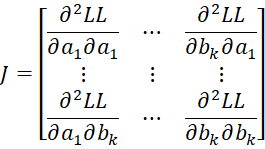Maximum Log-likelihood
Property 1: The maximum value of the log-likelihood function LL occurs when the following r+k-1 equations hold for h = 1 to r-1.
or alternatively
 and for j = 1 to k
and for j = 1 to k
where
Proof
The likelihood function is maximized when the first partial derivatives of LL with respect to the ah are zero for h = 1 to r-1 and the first partial derivatives of LL with respect to the bj are also zero for j = 1 to k. We define the following:
Thus
We also note that for 1 < h < r
from which it follows that
For h = 1 and h = r, we have
We next calculate various partial derivatives
For 1 < h < r, we have
For h = 1 and h = r, we get
Since pi0 = 0 and pir = 1, even when h = 1 or h = r
And so this result holds for 1 ≤ h ≤ r.
For 1 < h < r, we have
![]()
![]()
For h = 1, we have
and so for 1 ≤ h ≤ r-1
We next consider
which is valid for 0 < h < r-1. It is also valid for h = r-1 as can be seen from
We also note that
Finally, we now calculate the partial derivatives of LL using the results described above.
Since

it follows that for 0 < h < r
which completes the proof.
Jacobian matrix
Property A: The Jacobian matrix of the second partial derivatives of LL is an k+r-1 × k+r-1 symmetric matrix of form
where C = [chl] is an r-1 x r-1 matrix, D = [djg] is a k × k matrix and U = [ujh] is an k × r-1 matrix consisting of the following elements:
where

Proof
We calculate the various second partial derivatives of LL using the properties described in the proof of Property 1. We start with the
terms.

Next, we calculate the
terms.
Finally, we have the  case. First, we note that
case. First, we note that
which is also true in the following two cases:
We now start with the case where l = h.
If l = h + t where t ≥ 2, then
and so
Finally, we consider the case where and 0 < h < r-1, but first we note that
It now follows that
This completes the proof.
Newton’s Method
Property 2
Proof: Let
![]()


![]()
Using Newton’s method, we conclude that B* is a better estimate of the regression coefficients than B (i.e. it produces a larger value for LL), and so the sequence B, B*, B**, B***, etc. converges to the coefficient vector that maximizes LL and the corresponding Hessian matrix J-1 is a good estimate of the covariance matrix for the regression coefficients.
From Property 1, we see that the F vector can be expressed as
where

and by Property A, we see that the Jacobian matrix can be expressed as
where C = [chl], D = [djg] and U = [ujh] are as described in Property A. This completes the proof.
References
Hyun Sun Kim (2004) Topics in ordinal logistic regression and its applications. Dissertation Texas A & M
No longer accessible online
Agresti, A. (2013) Modeling Ordinal Categorical Data tutorial
http://statmath.wu.ac.at/research/talks/resources/slidesagresti_ordinal.pdf
McCullagh, P. (1980) The proportional odds model
https://www.stat.uchicago.edu/~pmcc/reports/prop_odds.pdf



































